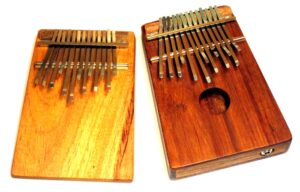
Use of this website constitutes acceptance of the Privacy Policy and User Agreement. Copyright © 2020 Kalimba Magic. All Rights Reserved.
I know that there are too many types of kalimbas and karimbas to keep track of. But little by little, I can address that with my Facebook Live events.
Please join me for a Facebook Live Session on the Modern Karimbas on Aug 26 2022, 3-4 PM MST (which is 6PM EDT). There is a one-day only 40% discount coupon code that will be revealed there.
The “Program” is a 2 page PDF document that lists the karimbas I’ll be playing, in order. I also indicate a few items you should pay attention to – right index finger technique for example. There are also links to relevant articles and links to the various karimba and book product pages.
And we also share a special 40% off coupon code, good for Aug 26 2022 only.
First of all… what is a KARIMBA? It is NOT a typo. I’ll give two answers: Karimbas tend to be traditional African instruments, or instruments tuned the same way as those traditional African instruments. And for today: Karimbas tend to have two rows of tines, a lower row and an upper row.
While there are a great many traditional karimbas, I think there are more non-traditional karimbas now. Some are simply minor modifications to the traditional karimbas’ tunings. But others are fundamentally new instruments. I will be taking a little tour of these karimbas, starting with the traditional karimbas.
And those non-traditional karimbas? Meaning kalimbas with two rows of tines? It turns out that these non-traditional instrument tunings and layouts are largely based on the traditional instruments. The non-African people who designeed these non-traditional karimbas all had a traditional African karimba in their hands. Their new creations were inspired by the traditional African instruments.

The first non-traditional karimba I will talk aboiut is the I Ching Kalimba. It was created by Gert Mortensen in the 1970s in Denmark, based on a traditional karimba. Mortensen commissioned composer Per Norgaard to create the piece “I Ching” for it. To me? The I Ching Kalimba sounds like a circus merry go round. It is a joyful instrument.
Around 2000, Peter Hokema was picking up after a kalimba jam. Someone had been using a frame drum to amplify one of the small kalimbas Hokema had made… and he plucked the tines just as he lifted the entire frame-drum-kalimba system, it went “wah”! By the way, there are traditional African kalimbas that make the wah, so it really is 1000-year-old African Technology. But Peter Hokema took it to the next level. Of course, nine notes can be very limiting melodically or harmonically. The standard A minor tuning is very enchanting… but the next frontier is exploring wonderful exotic tunings!
The Sansula was a remarkably successful kalimba innovation. To address the issue that 9-notes was very limiting (actually, the standard tuning has a redundant note, so there are only 8 independent notes), the 11-note B11 was introduced. Originally there was a model mounted on a larger frame drum (the B11 usually goes down to G, a whole step lower than the Sansula’s A, requiring a larger resonating body). But alas, 11 notes is still just 11 notes! So, there are more exotic B11 tunings!
One of the most important players in the non-traditional Karimba game is the new age musician SaReGaMa. Through a series of YouTube videos and musical recordings, SaReGaMa took a single Hugh Tracey Afrucan-tuned Karimba, and created new tunings every month or so. He could fine tune the tuning over time, and he created new music for each new tuning. His most popular tunings include the Lotus, the Freygish, and the Air tunings.
My own contribution to the Non-Traditional Karimba tunings is the Celtic D. It looks like the Freygish tuning, but it is in D major.
So, I will be performing something from the new Celtic D Karimba book!
Each different tuning? Each different setup? Each one evokes different musical possibilities and different musical feelings.
Again, we recognize these exotic instruments have all grown directly from traditional African kalimbas. Last week, I showed you how the Africans were innovating the instruments – how they would evolve the karimba, and how they would add notes and possibilities. This week, I show you how a bunch of people outside of Africa have done the same thing, transforming the musical possibilities the each unique instrument. However, these non-traditional instruments lacked the constraint that they play the old traditional music, and this let them drift much further away from the root instrument.


Sign up for our newsletter and free resources with your email address:
We pinky promise not to spam you and to only send good stuff.
 Assist Paul Tracey Rebuild His House in Pacific Palisades
Assist Paul Tracey Rebuild His House in Pacific Palisades 8-Note Spiral Kalimba Turned into a Student Karimba
8-Note Spiral Kalimba Turned into a Student Karimba Seek to Infuse Your Musical Moments With Beauty and Magic
Seek to Infuse Your Musical Moments With Beauty and MagicUse of this website constitutes acceptance of the Privacy Policy and User Agreement. Copyright © 2020 Kalimba Magic. All Rights Reserved.